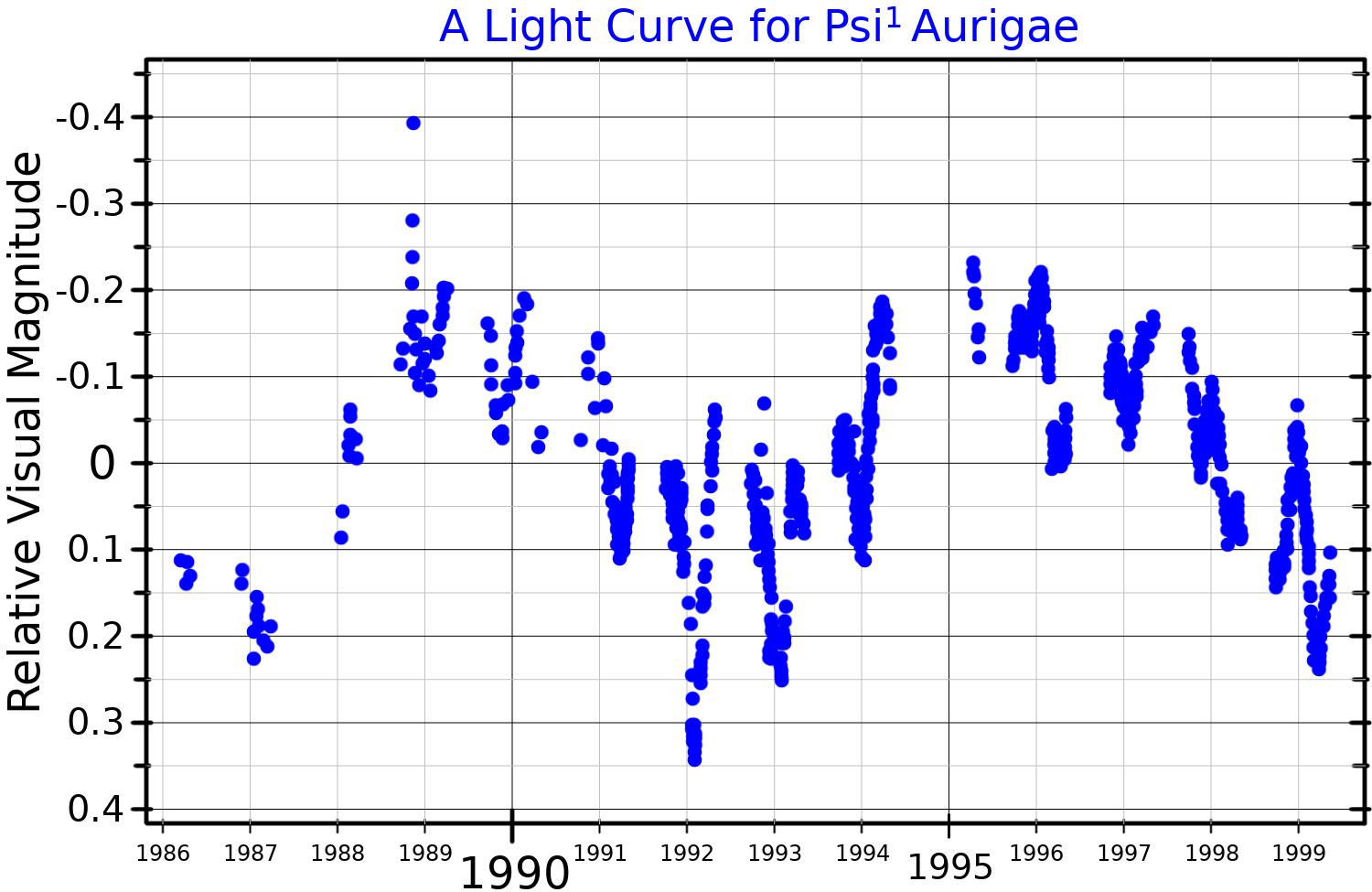Psi1 Aurigae on:
[Wikipedia]
[Google]
[Amazon]
Psi1 Aurigae is a  This is a massive
This is a massive
HR 2289
Image Psi1 Aurigae
{{DEFAULTSORT:Psi1 Aurigae M-type supergiants K-type supergiants Slow irregular variables Auriga Aurigae, Psi01 2289 Durchmusterung objects Aurigae, 46 044537 030520
star
A star is a luminous spheroid of plasma (physics), plasma held together by Self-gravitation, self-gravity. The List of nearest stars and brown dwarfs, nearest star to Earth is the Sun. Many other stars are visible to the naked eye at night sk ...
in the northern constellation
A constellation is an area on the celestial sphere in which a group of visible stars forms Asterism (astronomy), a perceived pattern or outline, typically representing an animal, mythological subject, or inanimate object.
The first constellati ...
of Auriga
Auriga is a constellation in the northern celestial hemisphere. It is one of the 88 modern constellations; it was among the 48 constellations listed by the 2nd-century astronomer Ptolemy. Its name is Latin for '(the) charioteer', associating i ...
. It name is a Bayer designation
A Bayer designation is a stellar designation in which a specific star is identified by a Greek alphabet, Greek or Latin letter followed by the genitive case, genitive form of its parent constellation's Latin name. The original list of Bayer design ...
that is Latinized from ψ1 Aurigae, and abbreviated Psi1 Aur or ψ1 Aur. This star is faintly visible to the naked eye
Naked eye, also called bare eye or unaided eye, is the practice of engaging in visual perception unaided by a magnification, magnifying, Optical telescope#Light-gathering power, light-collecting optical instrument, such as a telescope or microsc ...
with an apparent visual magnitude
Apparent magnitude () is a measure of the brightness of a star, astronomical object or other celestial objects like artificial satellites. Its value depends on its intrinsic luminosity, its distance, and any extinction of the object's light ca ...
of 4.91. Based upon a measured annual parallax
Parallax is a displacement or difference in the apparent position of an object viewed along two different sightline, lines of sight and is measured by the angle or half-angle of inclination between those two lines. Due to perspective (graphica ...
shift of , it is approximately distant from the Earth. It is receding from the Sun
The Sun is the star at the centre of the Solar System. It is a massive, nearly perfect sphere of hot plasma, heated to incandescence by nuclear fusion reactions in its core, radiating the energy from its surface mainly as visible light a ...
with a radial velocity
The radial velocity or line-of-sight velocity of a target with respect to an observer is the rate of change of the vector displacement between the two points. It is formulated as the vector projection of the target-observer relative velocity ...
of +4.7 km/s.
 This is a massive
This is a massive supergiant
Supergiants are among the most massive and most luminous stars. Supergiant stars occupy the top region of the Hertzsprung–Russell diagram, with absolute visual magnitudes between about −3 and −8. The temperatures of supergiant stars range ...
star with a stellar classification
In astronomy, stellar classification is the classification of stars based on their stellar spectrum, spectral characteristics. Electromagnetic radiation from the star is analyzed by splitting it with a Prism (optics), prism or diffraction gratin ...
of K5-M1Iab-Ib. It is a slow irregular variable
A slow irregular variable (ascribed the GCVS types L, LB and LC) is a variable star that exhibit no or very poorly defined periodicity in their slowly changing light emissions. These stars have often been little-studied, and once more is learnt a ...
of the LC type, with its brightness varying in magnitude by 0.44. The star is more than 14 times as massive as the Sun, over 900 times larger, and is blazing with 170,000 times the Sun's luminosity. It is one of the largest stars known, even larger and more luminous than well-known red supergiants Betelgeuse
Betelgeuse is a red supergiant star in the constellation of Orion (constellation), Orion. It is usually the List of brightest stars, tenth-brightest star in the night sky and, after Rigel, the second brightest in its constellation. It i ...
and Antares
Antares is the brightest star in the constellation of Scorpius. It has the Bayer designation α Scorpii, which is Latinisation of names, Latinised to Alpha Scorpii. Often referred to as "the heart of the scorpion", Antares is flanked by ...
. This energy is being radiated into outer space from its outer atmosphere at an effective temperature
The effective temperature of a body such as a star or planet is the temperature of a black body that would emit the same total amount of electromagnetic radiation. Effective temperature is often used as an estimate of a body's surface temperature ...
of 3,790 K, giving it the orange-red hue of a cool M-type star
In astronomy, stellar classification is the classification of stars based on their spectral characteristics. Electromagnetic radiation from the star is analyzed by splitting it with a prism or diffraction grating into a spectrum exhibiting the ...
.
See also
*List of largest known stars
A list is a set of discrete items of information collected and set forth in some format for utility, entertainment, or other purposes. A list may be memorialized in any number of ways, including existing only in the mind of the list-maker, but ...
Notes
References
External links
HR 2289
Image Psi1 Aurigae
{{DEFAULTSORT:Psi1 Aurigae M-type supergiants K-type supergiants Slow irregular variables Auriga Aurigae, Psi01 2289 Durchmusterung objects Aurigae, 46 044537 030520